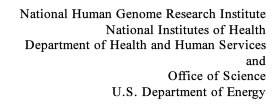Last updated: September 01, 2006
What's Next?- Turning Genomics Vision Into Reality
 |
What's Next?
Turning Genomics Vision Into Reality
In "A Vision for the Future of Genomics Research," published in the April 24, 2003 issue of the journal Nature, the National Human Genome Research Institute (NHGRI) details a myriad of research opportunities in the genome era. This backgrounder describes a few of the more visible, large-scale opportunities.
The International HapMap Project
Launched in October 2002 by NHGRI and its partners, the International HapMap Project has enlisted a worldwide consortium of scientists with the goal of producing the "next-generation" map of the human genome to speed the discovery of genes related to common illnesses such as asthma, cancer, diabetes and heart disease.
Expected to take three years to complete, the "HapMap" will chart genetic variation within the human genome at an unprecedented level of precision. By comparing genetic differences among individuals and identifying those specifically associated with a condition, consortium members believe they can create a tool to help researchers detect the genetic contributions to many diseases. Whereas the Human Genome Project provided the foundation on which researchers are making dramatic genetic discoveries, the HapMap will begin building the framework to make the results of genomic research applicable to individuals.
ENCyclopedia Of DNA Elements (ENCODE)
This NHGRI-led project is designed to develop efficient ways of identifying and precisely locating all of the protein-coding genes, non-protein-coding genes and other sequence-based, functional elements contained in the human DNA sequence. Creating this monumental reference work will help scientists mine and fully utilize the human sequence, gain a deeper understanding of human biology, predict potential disease risk, and develop new strategies for the prevention and treatment of disease.
The ENCODE project will begin as a pilot, in which participating research teams will work cooperatively to develop efficient, high-throughput methods for rigorously and fully analyzing a defined set of target regions comprising approximately 1 percent of the human genome. Analysis of this first 30 megabases (Mb) of human genome sequence will allow the project participants to test and compare a variety of existing and new technologies to find the functional elements in human DNA.
Chemical Genomics
NHGRI is exploring the acquisition and/or creation of publicly available libraries of organic chemical compounds, also referred to as small molecules, for use by basic scientists in their efforts to chart biological pathways. Such compounds have a number of attractive features for genome analysis, including their wide structural diversity, which mirrors the diversity of the genome; their ability in many cases to enter cells readily; and the fact that they can often serve as starting points for drug development. The use of these chemical compounds to probe gene function will complement more conventional nucleic acid approaches.
This initiative offers enormous potential. However, it is a fundamentally new approach to genomics, and largely new to basic biomedical research as a whole. As a result, substantial investments in physical and human capital will be needed. NHGRI is currently planning for these needs, which will include large libraries of chemical compounds (500,000 - 1,000,000 total); capacity for robotic-enabled, high-throughput screening; and medicinal chemistry to convert compounds identified through such screening into useful biological tools.
Genomes to Life
The Department of Energy's "Genomes to Life" program focuses on single-cell organisms, or microbes. The fundamental goal is to understand the intricate details of the life processes of microbes so well that computational models can be developed to accurately describe and predict their responses to changes in their environment.
"Genomes to Life" aims to understand the activities of single-cell organisms on three levels: the proteins and multi-molecular machines that perform most of the cell's work; the gene regulatory networks that control these processes; and microbial associations or communities in which groups of different microbes carry out fundamental functions in nature. Once researchers understand how life functions at the microbial level, they hope to use the capabilities of these organisms to help meet many of our national challenges in energy and the environment.
Visit the Genomes to Life Web Site [doegenomestolife.org]
Structural Genomics Consortium
Structural genomics is the systematic, high-throughput generation of the three-dimensional structure of proteins. The ultimate goal for studying the structural genomics of any organism is the complete structural description of all proteins encoded by the genome of that organism. Such three-dimensional structures will be crucial for rational drug design, for diagnosis and treatment of disease, and for advancing our understanding of basic biology. A broad collection of structures will provide valuable biological information beyond that which can be obtained from individual structures.
To complement various international efforts in structural genomics, the United Kingdom's Wellcome Trust is considering creating a charitable organization - the Structural Genomics Consortium - with a group of pharmaceutical and other companies. The model for the new consortium would be the highly successful SNP Consortium formed in 1999 by the Trust and 12 companies to map human genetic variations, called single nucleotide polymorphisms (SNPs). Like the SNP Consortium, the Structural Genomics Consortium will develop pre-competitive data, placing all protein structures in public databases.
For more information on the Structural Genomics Consortium, visit The Wellcome Trust Web site [wellcome.ac.uk].
